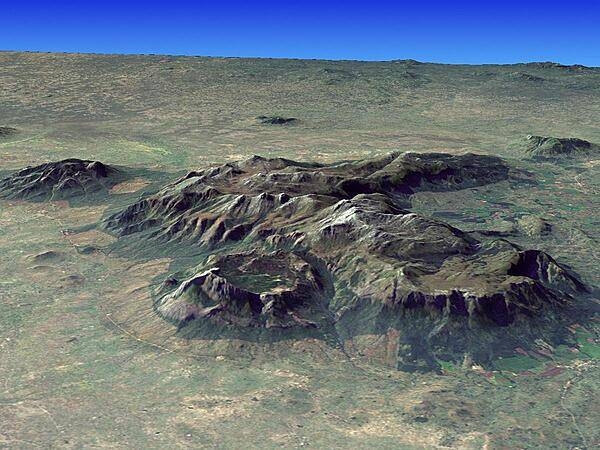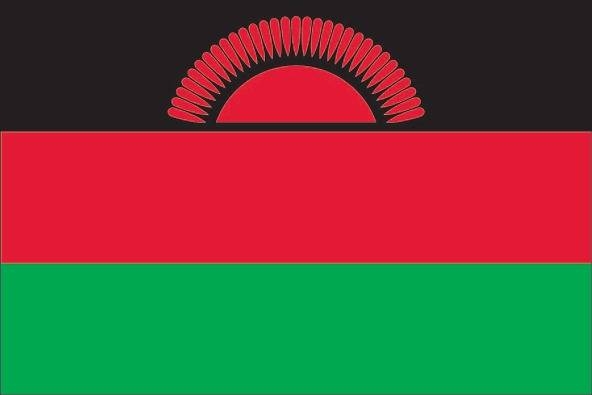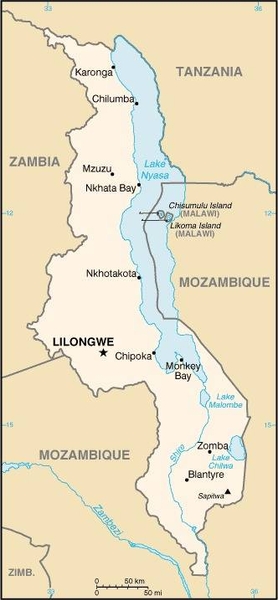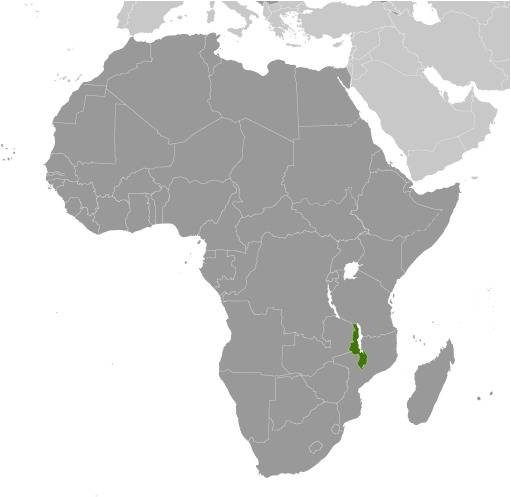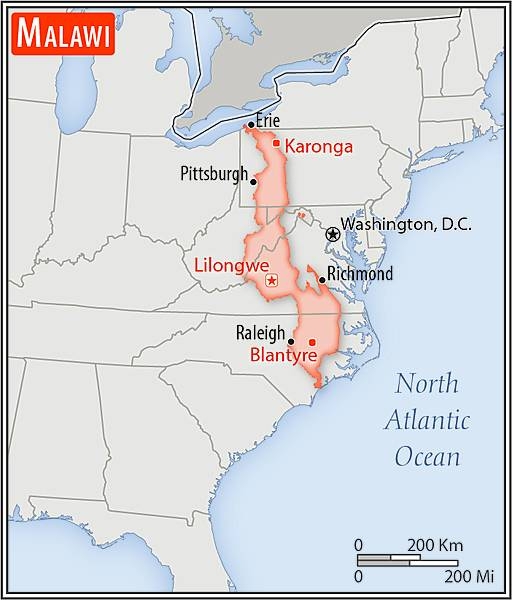Introduction
Background
Malawi shares its name with the Chewa word for flames and is linked to the Maravi people from whom the Chewa language originated. The Maravi settled in what is now Malawi around 1400 during one of the later waves of Bantu migration across central and southern Africa. Several of Malawi’s ethnic groups trace their origins to different Maravi lineages. A powerful Maravi kingdom, established around 1500, reached its zenith around 1700, when it controlled what is now southern and central Malawi as well as portions of neighboring Mozambique and Zambia before beginning to decline because of destabilization from the escalating global trade in enslaved people. In the early 1800s, widespread conflict in southern Africa displaced various ethnic Ngoni groups, some of which moved into Malawi and further undermined the Maravi. Members of the Yao ethnic group - which had long traded with Malawi from Mozambique - introduced Islam and began to settle in Malawi in significant numbers in the mid-1800s; in the late 1800s, members of the Lomwe ethnic group also moved into southern Malawi from Mozambique. British missionary and trading activity increased in the area around Lake Nyasa in the mid-1800s, and Britain declared a protectorate, called British Central Africa, over what is now Malawi in 1891 and eliminated various political entities that sought to retain their autonomy over the subsequent decade. The British renamed the territory Nyasaland in 1907 and it was part of the colonial Federation of Rhodesia and Nyasaland - including present-day Zambia and Zimbabwe - from 1953 to 1963 before gaining independence as Malawi in 1964.
Hastings Kamuzu BANDA served as prime minister at independence and, when the country became a republic in 1966, he became president. He later instituted one-party rule under his Malawi Congress Party (MCP) and was declared president for life. After three decades of one-party rule, the country held multiparty presidential and parliamentary elections in 1994 under a provisional constitution that came into full effect the following year. Bakili MULUZI of the United Democratic Front party became the first freely elected president of Malawi when he defeated BANDA at the polls in 1994; he won reelection in 1999. President Bingu wa MUTHARIKA was elected in 2004 and subsequently started his own party, the Democratic Progressive Party, in 2005. MUTHARIKA was reelected to a second term in 2009. He died abruptly in 2012 and was succeeded by Vice President Joyce BANDA, who had earlier started her own party, the People's Party. MUTHARIKA's brother, Peter MUTHARIKA, defeated BANDA in the election in 2014. Peter MUTHARIKA was reelected in a disputed election in 2019 that resulted in countrywide protests. The courts ordered a new the election, and in 2020 Lazarus CHAKWERA of the MCP was elected president after defeating MUTHARIKA as head of a coalition of opposition parties. Population growth, increasing pressure on agricultural lands, corruption, and the scourge of HIV/AIDS pose major problems for Malawi.
Visit the Definitions and Notes page to view a description of each topic.
Geography
Location
Southern Africa, east of Zambia, west and north of Mozambique
Geographic coordinates
13 30 S, 34 00 E
Map references
Africa
Land boundaries
total: 2,857 km
border countries (3): Mozambique 1,498 km; Tanzania 512 km; Zambia 847 km
Coastline
0 km (landlocked)
Maritime claims
none (landlocked)
Climate
sub-tropical; rainy season (November to May); dry season (May to November)
Terrain
narrow elongated plateau with rolling plains, rounded hills, some mountains
Elevation
highest point: Sapitwa (Mount Mlanje) 3,002 m
lowest point: junction of the Shire River and international boundary with Mozambique 37 m
mean elevation: 779 m
Natural resources
limestone, arable land, hydropower, unexploited deposits of uranium, coal, and bauxite
Land use
agricultural land: 59.2% (2018 est.)
arable land: 38.2% (2018 est.)
permanent crops: 1.4% (2018 est.)
permanent pasture: 19.6% (2018 est.)
forest: 34% (2018 est.)
other: 6.8% (2018 est.)
Irrigated land
740 sq km (2012)
Major lakes (area sq km)
fresh water lake(s): Lake Malawi (shared with Mozambique and Tanzania) - 22,490
salt water lake(s): Lake Chilwa - 1,040 sq km
Major rivers (by length in km)
Zambezi (shared with Zambia [s], Angola, Zimbabwe, Namibia, Tanzania, and Mozambique [m]) - 2,740 km
note – [s] after country name indicates river source; [m] after country name indicates river mouth
Major watersheds (area sq km)
Atlantic Ocean drainage: Congo (3,730,881 sq km)
Indian Ocean drainage: Zambezi (1,332,412 sq km)
Population distribution
population density is highest south of Lake Nyasa as shown in this population distribution map
Natural hazards
flooding; droughts; earthquakes
Geography - note
landlocked; Lake Nyasa, some 580 km long, is the country's most prominent physical feature; it contains more fish species than any other lake on earth
People and Society
Nationality
noun: Malawian(s)
adjective: Malawian
Ethnic groups
Chewa 34.3%, Lomwe 18.8%, Yao 13.2%, Ngoni 10.4%, Tumbuka 9.2%, Sena 3.8%, Mang'anja 3.2%, Tonga 1.8%, Nyanja 1.8%, Nkhonde 1%, other 2.2%, foreign 0.3% (2018 est.)
Languages
English (official), Chewa (common), Lambya, Lomwe, Ngoni, Nkhonde, Nyakyusa, Nyanja, Sena, Tonga, Tumbuka, Yao
note: Chewa and Nyanja are mutually intelligible dialects; Nkhonde and Nyakyusa are mutually intelligible dialects
Religions
Protestant 33.5% (includes Church of Central Africa Presbyterian 14.2%, Seventh Day Adventist/Baptist 9.4%, Pentecostal 7.6%, Anglican 2.3%), Roman Catholic 17.2%, other Christian 26.6%, Muslim 13.8%, traditionalist 1.1%, other 5.6%, none 2.1% (2018 est.)
Demographic profile
Malawi has made great improvements in maternal and child health, but has made less progress in reducing its high fertility rate. In both rural and urban areas, very high proportions of mothers are receiving prenatal care and skilled birth assistance, and most children are being vaccinated. Malawi’s fertility rate, however, has only declined slowly, decreasing from more than 7 children per woman in the 1980s to about 5.5 today. Nonetheless, Malawians prefer smaller families than in the past, and women are increasingly using contraceptives to prevent or space pregnancies. Rapid population growth and high population density is putting pressure on Malawi’s land, water, and forest resources. Reduced plot sizes and increasing vulnerability to climate change, further threaten the sustainability of Malawi’s agriculturally based economy and will worsen food shortages. About 80% of the population is employed in agriculture.
Historically, Malawians migrated abroad in search of work, primarily to South Africa and present-day Zimbabwe, but international migration became uncommon after the 1970s, and most migration in recent years has been internal. During the colonial period, Malawians regularly migrated to southern Africa as contract farm laborers, miners, and domestic servants. In the decade and a half after independence in 1964, the Malawian Government sought to transform its economy from one dependent on small-scale farms to one based on estate agriculture. The resulting demand for wage labor induced more than 300,000 Malawians to return home between the mid-1960s and the mid-1970s. In recent times, internal migration has generally been local, motivated more by marriage than economic reasons.
Age structure
0-14 years: 45.87% (male 4,843,107/female 4,878,983)
15-24 years: 20.51% (male 2,151,417/female 2,195,939)
25-54 years: 27.96% (male 2,944,936/female 2,982,195)
55-64 years: 2.98% (male 303,803/female 328,092)
65 years and over: 2.68% (male 249,219/female 318,938) (2020 est.)
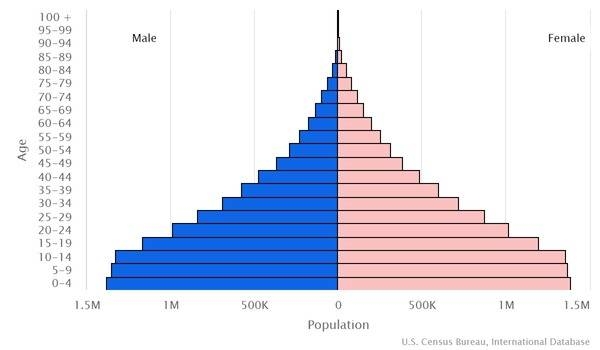
Dependency ratios
total dependency ratio: 84.7
youth dependency ratio: 79.7
elderly dependency ratio: 5
potential support ratio: 20.1 (2021 est.)
Median age
total: 16.8 years
male: 16.7 years
female: 16.9 years (2020 est.)
Population distribution
population density is highest south of Lake Nyasa as shown in this population distribution map
Urbanization
urban population: 18.3% of total population (2023)
rate of urbanization: 4.41% annual rate of change (2020-25 est.)
Major urban areas - population
1.276 million LILONGWE (capital), 1.031 million Blantyre-Limbe (2023)
Sex ratio
at birth: 1.02 male(s)/female
0-14 years: 0.99 male(s)/female
15-24 years: 0.97 male(s)/female
25-54 years: 0.95 male(s)/female
55-64 years: 0.9 male(s)/female
65 years and over: 0.64 male(s)/female
total population: 0.96 male(s)/female (2022 est.)
Mother's mean age at first birth
19.1 years (2015/16 est.)
note: data represents median age at first birth among women 20-49
Maternal mortality ratio
349 deaths/100,000 live births (2017 est.)
country comparison to the world: 31Infant mortality rate
total: 33.43 deaths/1,000 live births
male: 37.86 deaths/1,000 live births
female: 28.93 deaths/1,000 live births (2022 est.)
Life expectancy at birth
total population: 72.44 years
male: 69.33 years
female: 75.59 years (2022 est.)
Contraceptive prevalence rate
65.6% (2019/20)
Drinking water source
improved: urban: 96.7% of population
rural: 91% of population
total: 92% of population
unimproved: urban: 3.3% of population
rural: 9% of population
total: 8% of population (2020 est.)
Current health expenditure
7.4% of GDP (2019)
Physicians density
0.05 physicians/1,000 population (2020)
Hospital bed density
1.3 beds/1,000 population (2011)
Sanitation facility access
improved: urban: 59.9% of population
rural: 35.9% of population
total: 40% of population
unimproved: urban: 40.1% of population
rural: 64.1% of population
total: 60% of population (2020 est.)
Major infectious diseases
degree of risk: very high (2020)
food or waterborne diseases: bacterial and protozoal diarrhea, hepatitis A, and typhoid fever
vectorborne diseases: malaria and dengue fever
water contact diseases: schistosomiasis
animal contact diseases: rabies
note: on 21 March 2022, the US Centers for Disease Control and Prevention (CDC) issued a Travel Alert for polio in Africa; Malawi is currently considered a high risk to travelers for circulating vaccine-derived polioviruses (cVDPV); vaccine-derived poliovirus (VDPV) is a strain of the weakened poliovirus that was initially included in oral polio vaccine (OPV) and that has changed over time and behaves more like the wild or naturally occurring virus; this means it can be spread more easily to people who are unvaccinated against polio and who come in contact with the stool or respiratory secretions, such as from a sneeze, of an “infected” person who received oral polio vaccine; the CDC recommends that before any international travel, anyone unvaccinated, incompletely vaccinated, or with an unknown polio vaccination status should complete the routine polio vaccine series; before travel to any high-risk destination, the CDC recommends that adults who previously completed the full, routine polio vaccine series receive a single, lifetime booster dose of polio vaccine
Alcohol consumption per capita
total: 2.04 liters of pure alcohol (2019 est.)
beer: 0.08 liters of pure alcohol (2019 est.)
wine: 0 liters of pure alcohol (2019 est.)
spirits: 0.25 liters of pure alcohol (2019 est.)
other alcohols: 1.7 liters of pure alcohol (2019 est.)
Tobacco use
total: 10.8% (2020 est.)
male: 17.5% (2020 est.)
female: 4.1% (2020 est.)
Literacy
definition: age 15 and over can read and write
total population: 62.1%
male: 69.8%
female: 55.2% (2015)
School life expectancy (primary to tertiary education)
total: 11 years
male: 11 years
female: 11 years (2011)
Youth unemployment rate (ages 15-24)
total: 1.2%
male: 1%
female: 1.4% (2020 est.)
Environment
Environment - current issues
deforestation; land degradation; water pollution from agricultural runoff, sewage, industrial wastes; siltation of spawning grounds endangers fish populations; negative effects of climate change (extreme high temperatures, changing precipitation patterns)
Environment - international agreements
party to: Biodiversity, Climate Change, Climate Change-Kyoto Protocol, Climate Change-Paris Agreement, Comprehensive Nuclear Test Ban, Desertification, Endangered Species, Environmental Modification, Hazardous Wastes, Law of the Sea, Marine Life Conservation, Nuclear Test Ban, Ozone Layer Protection, Ship Pollution, Wetlands
signed, but not ratified: none of the selected agreements
Air pollutants
particulate matter emissions: 22.14 micrograms per cubic meter (2016 est.)
carbon dioxide emissions: 1.3 megatons (2016 est.)
methane emissions: 11.12 megatons (2020 est.)
Climate
sub-tropical; rainy season (November to May); dry season (May to November)
Land use
agricultural land: 59.2% (2018 est.)
arable land: 38.2% (2018 est.)
permanent crops: 1.4% (2018 est.)
permanent pasture: 19.6% (2018 est.)
forest: 34% (2018 est.)
other: 6.8% (2018 est.)
Urbanization
urban population: 18.3% of total population (2023)
rate of urbanization: 4.41% annual rate of change (2020-25 est.)
Revenue from forest resources
forest revenues: 6.19% of GDP (2018 est.)
country comparison to the world: 10Major infectious diseases
degree of risk: very high (2020)
food or waterborne diseases: bacterial and protozoal diarrhea, hepatitis A, and typhoid fever
vectorborne diseases: malaria and dengue fever
water contact diseases: schistosomiasis
animal contact diseases: rabies
note: on 21 March 2022, the US Centers for Disease Control and Prevention (CDC) issued a Travel Alert for polio in Africa; Malawi is currently considered a high risk to travelers for circulating vaccine-derived polioviruses (cVDPV); vaccine-derived poliovirus (VDPV) is a strain of the weakened poliovirus that was initially included in oral polio vaccine (OPV) and that has changed over time and behaves more like the wild or naturally occurring virus; this means it can be spread more easily to people who are unvaccinated against polio and who come in contact with the stool or respiratory secretions, such as from a sneeze, of an “infected” person who received oral polio vaccine; the CDC recommends that before any international travel, anyone unvaccinated, incompletely vaccinated, or with an unknown polio vaccination status should complete the routine polio vaccine series; before travel to any high-risk destination, the CDC recommends that adults who previously completed the full, routine polio vaccine series receive a single, lifetime booster dose of polio vaccine
Food insecurity
severe localized food insecurity: due to reduced incomes and shortfalls in cereal production - an estimated 1.65 million people are facing “Crisis” levels of food insecurity between January and March 2022, underpinned by localized shortfalls in cereal production and the lingering impact of an economic downturn due to the COVID-19 pandemic; a moderate decline in cereal production in 2022, particularly in southern districts, and increasing food prices are expected to lead to an increased prevalence of food insecurity in the last quarter of 2022; the prevalence of food insecurity is likely to increase in the second half of 2022 and early 2023 mainly due to the high food prices and low cereal production in southern districts; in addition to the adverse impacts of the low cereal harvest in the south and high food prices across the country, a third factor that is foreseen to contribute to a worsening of food insecurity conditions is the forecasted slow economic growth in 2022, underpinned by the lingering effects of the COVID-19 pandemic and the country’s elevated debt levels (2022)
Waste and recycling
municipal solid waste generated annually: 1,297,844 tons (2013 est.)
Major lakes (area sq km)
fresh water lake(s): Lake Malawi (shared with Mozambique and Tanzania) - 22,490
salt water lake(s): Lake Chilwa - 1,040 sq km
Major rivers (by length in km)
Zambezi (shared with Zambia [s], Angola, Zimbabwe, Namibia, Tanzania, and Mozambique [m]) - 2,740 km
note – [s] after country name indicates river source; [m] after country name indicates river mouth
Major watersheds (area sq km)
Atlantic Ocean drainage: Congo (3,730,881 sq km)
Indian Ocean drainage: Zambezi (1,332,412 sq km)
Total water withdrawal
municipal: 143.1 million cubic meters (2017 est.)
industrial: 47.7 million cubic meters (2017 est.)
agricultural: 1.166 billion cubic meters (2017 est.)
Total renewable water resources
17.28 billion cubic meters (2017 est.)
Government
Country name
conventional long form: Republic of Malawi
conventional short form: Malawi
local long form: Dziko la Malawi
local short form: Malawi
former: British Central African Protectorate, Nyasaland Protectorate, Nyasaland
etymology: named for the East African Maravi Kingdom of the 16th century; the word "maravi" means "fire flames"
Government type
presidential republic
Capital
name: Lilongwe
geographic coordinates: 13 58 S, 33 47 E
time difference: UTC+2 (7 hours ahead of Washington, DC, during Standard Time)
etymology: named after the Lilongwe River that flows through the city
Administrative divisions
28 districts; Balaka, Blantyre, Chikwawa, Chiradzulu, Chitipa, Dedza, Dowa, Karonga, Kasungu, Likoma, Lilongwe, Machinga, Mangochi, Mchinji, Mulanje, Mwanza, Mzimba, Neno, Ntcheu, Nkhata Bay, Nkhotakota, Nsanje, Ntchisi, Phalombe, Rumphi, Salima, Thyolo, Zomba
Independence
6 July 1964 (from the UK)
National holiday
Independence Day, 6 July (1964); note - also called Republic Day since 6 July 1966
Constitution
history: previous 1953 (preindependence), 1964, 1966; latest drafted January to May 1994, approved 16 May 1994, entered into force 18 May 1995
amendments: proposed by the National Assembly; passage of amendments affecting constitutional articles, including the sovereignty and territory of the state, fundamental constitutional principles, human rights, voting rights, and the judiciary, requires majority approval in a referendum and majority approval by the Assembly; passage of other amendments requires at least two-thirds majority vote of the Assembly; amended several times, last in 2017
Legal system
mixed legal system of English common law and customary law; judicial review of legislative acts in the Supreme Court of Appeal
International law organization participation
accepts compulsory ICJ jurisdiction with reservations; accepts ICCt jurisdiction
Citizenship
citizenship by birth: no
citizenship by descent only: at least one parent must be a citizen of Malawi
dual citizenship recognized: no
residency requirement for naturalization: 7 years
Suffrage
18 years of age; universal
Executive branch
chief of state: President Lazarus CHAKWERA (since 28 June 2020); Vice President Saulos CHILIMA (since 3 February 2020); note - the president is both chief of state and head of government
head of government: President Lazarus CHAKWERA (since 28 June 2020); Vice President Saulos CHILIMA (since 3 February 2020)
cabinet: Cabinet named by the president
elections/appointments: president directly elected by simple majority popular vote for a 5-year term (eligible for a second term); election last held on 23 June 2020 (next to be held in 2025)
election results: Lazarus CHAKWERA elected president; Lazarus CHAKWERA (MCP) 59.3%, Peter Mutharika (DPP) 39.9%, other 0.8% (2020)
Legislative branch
description: unicameral National Assembly (193 seats; members directly elected in single-seat constituencies by simple majority vote to serve 5-year terms)
elections: last held on 21 May 2019 (next to be held in May 2024)
election results: percent of vote by party - n/a; seats by party - DPP 62, MCP 55, UDF 10, PP 5, other 5, independent 55, vacant 1; composition - men 161, women 32, percent of women 16.6%
Judicial branch
highest court(s): Supreme Court of Appeal (consists of the chief justice and at least 3 judges)
judge selection and term of office: Supreme Court chief justice appointed by the president and confirmed by the National Assembly; other judges appointed by the president upon the recommendation of the Judicial Service Commission, which regulates judicial officers; judges serve until age 65
subordinate courts: High Court; magistrate courts; Industrial Relations Court; district and city traditional or local courts
Political parties and leaders
Democratic Progressive Party or DPP [Peter MUTHARIKA]
Malawi Congress Party or MCP [Lazarus CHAKWERA]
People's Party or PP [Joyce BANDA]
United Democratic Front or UDF
United Transformation Movement or UTM [Saulos CHILIMA]
International organization participation
ACP, AfDB, AU, C, CD, COMESA, FAO, G-77, IAEA, IBRD, ICAO, ICCt, ICRM, IDA, IFAD, IFC, IFRCS, ILO, IMF, IMO, Interpol, IOC, IOM, IPU, ISO (correspondent), ITSO, ITU, ITUC (NGOs), MIGA, MINURSO, MONUSCO, NAM, OPCW, SADC, UN, UNCTAD, UNESCO, UNHRC, UNIDO, UNISFA, UNOCI, UNWTO, UPU, WCO, WFTU (NGOs), WHO, WIPO, WMO, WTO
Diplomatic representation in the US
chief of mission: Ambassador Esme Jynet CHOMBO (since 19 April 2022)
chancery: 2408 Massachusetts Avenue NW, Washington, DC 20008
telephone: [1] (202) 721-0270
FAX: [1] (202) 721-0288
email address and website:
malawiembassy-dc.org
http://www.malawiembassy-dc.org/
Diplomatic representation from the US
chief of mission: Ambassador David YOUNG (since 5 May 2022)
embassy: 16 Jomo Kenyatta Road, Lilongwe 3
mailing address: 2280 Lilongwe Place, Washington DC 20521-2280
telephone: [265] (0) 177-3166
FAX: [265] (0) 177-0471
email address and website:
LilongweConsular@state.gov
https://mw.usembassy.gov/
Flag description
three equal horizontal bands of black (top), red, and green with a radiant, rising, red sun centered on the black band; black represents the native peoples, red the blood shed in their struggle for freedom, and green the color of nature; the rising sun represents the hope of freedom for the continent of Africa
National symbol(s)
lion; national colors: black, red, green
National anthem
name: "Mulungu dalitsa Malawi" (Oh God Bless Our Land of Malawi)
lyrics/music: Michael-Fredrick Paul SAUKA
note: adopted 1964
National heritage
total World Heritage Sites: 2 (1 cultural, 1 natural)
selected World Heritage Site locales: Lake Malawi National Park (n); Chongoni Rock-Art Area (c)
Economy
Economic overview
Landlocked Malawi ranks among the world's least developed countries. The country’s economic performance has historically been constrained by policy inconsistency, macroeconomic instability, poor infrastructure, rampant corruption, high population growth, and poor health and education outcomes that limit labor productivity. The economy is predominately agricultural with about 80% of the population living in rural areas. Agriculture accounts for about one-third of GDP and 80% of export revenues. The performance of the tobacco sector is key to short-term growth as tobacco accounts for more than half of exports, although Malawi is looking to diversify away from tobacco to other cash crops.
The economy depends on substantial inflows of economic assistance from the IMF, the World Bank, and individual donor nations. Donors halted direct budget support from 2013 to 2016 because of concerns about corruption and fiscal carelessness, but the World Bank resumed budget support in May 2017. In 2006, Malawi was approved for relief under the Heavily Indebted Poor Countries (HIPC) program but recent increases in domestic borrowing mean that debt servicing in 2016 exceeded the levels prior to HIPC debt relief.
Heavily dependent on rain-fed agriculture, with corn being the staple crop, Malawi’s economy was hit hard by the El Nino-driven drought in 2015 and 2016, and now faces threat from the fall armyworm. The drought also slowed economic activity, led to two consecutive years of declining economic growth, and contributed to high inflation rates. Depressed food prices over 2017 led to a significant drop in inflation (from an average of 21.7% in 2016 to 12.3% in 2017), with a similar drop in interest rates.
Real GDP (purchasing power parity)
$28.44 billion (2020 est.)
$28.22 billion (2019 est.)
$26.69 billion (2018 est.)
note: data are in 2017 dollars
Real GDP per capita
$1,500 (2020 est.)
$1,500 (2019 est.)
$1,500 (2018 est.)
note: data are in 2017 dollars
GDP (official exchange rate)
$7.766 billion (2019 est.)
Inflation rate (consumer prices)
9.3% (2019 est.)
12.4% (2018 est.)
11.7% (2017 est.)
GDP - composition, by sector of origin
agriculture: 28.6% (2017 est.)
industry: 15.4% (2017 est.)
services: 56% (2017 est.)
GDP - composition, by end use
household consumption: 84.3% (2017 est.)
government consumption: 16.3% (2017 est.)
investment in fixed capital: 15.3% (2017 est.)
investment in inventories: 0% (2017 est.)
exports of goods and services: 27.9% (2017 est.)
imports of goods and services: -43.8% (2017 est.)
Agricultural products
sweet potatoes, cassava, sugar cane, maize, mangoes/guavas, potatoes, tomatoes, pigeon peas, bananas, plantains
Industries
tobacco, tea, sugar, sawmill products, cement, consumer goods
Labor force - by occupation
agriculture: 76.9%
industry: 4.1%
services: 19% (2013 est.)
Youth unemployment rate (ages 15-24)
total: 1.2%
male: 1%
female: 1.4% (2020 est.)
Population below poverty line
51.5% (2016 est.)
Gini Index coefficient - distribution of family income
44.7 (2016 est.)
39 (2004)
Household income or consumption by percentage share
lowest 10%: 2.2%
highest 10%: 37.5% (2010 est.)
Budget
revenues: 1.356 billion (2017 est.)
expenditures: 1.567 billion (2017 est.)
Fiscal year
1 July - 30 June
Current account balance
-$591 million (2017 est.)
-$744 million (2016 est.)
Exports
$1.16 billion (2019 est.) note: data are in current year dollars
$1.11 billion (2018 est.) note: data are in current year dollars
$9.658 billion (2017 est.)
Exports - partners
Belgium 16%, United States 8%, Egypt 7%, South Africa 6%, Germany 6%, Kenya 5%, United Arab Emirates 5% (2019)
Exports - commodities
tobacco, tea, raw sugar, beans, soybean products, clothing and apparel (2019)
Imports
$3.2 billion (2019 est.) note: data are in current year dollars
$2.92 billion (2018 est.) note: data are in current year dollars
$11.631 billion (2017 est.)
Imports - partners
South Africa 17%, China 16%, United Arab Emirates 9%, India 9%, United Kingdom 8% (2019)
Imports - commodities
postage stamps, refined petroleum, packaged medicines, fertilizers, office machinery/parts (2019)
Reserves of foreign exchange and gold
$780.2 million (31 December 2017 est.)
$585.7 million (31 December 2016 est.)
Debt - external
$2.102 billion (31 December 2017 est.)
$1.5 billion (31 December 2016 est.)
Exchange rates
Malawian kwachas (MWK) per US dollar -
762.4951 (2020 est.)
736.6548 (2019 est.)
732.335 (2018 est.)
499.6 (2014 est.)
424.9 (2013 est.)
Energy
Electricity access
electrification - total population: 13% (2019)
electrification - urban areas: 55% (2019)
electrification - rural areas: 5% (2019)
Electricity
installed generating capacity: 618,000 kW (2020 est.)
consumption: 1,117,378,000 kWh (2019 est.)
exports: 0 kWh (2019 est.)
imports: 0 kWh (2019 est.)
transmission/distribution losses: 460 million kWh (2019 est.)
Electricity generation sources
fossil fuels: 11.8% of total installed capacity (2020 est.)
nuclear: 0% of total installed capacity (2020 est.)
solar: 3.2% of total installed capacity (2020 est.)
wind: 0% of total installed capacity (2020 est.)
hydroelectricity: 81.9% of total installed capacity (2020 est.)
tide and wave: 0% of total installed capacity (2020 est.)
geothermal: 0% of total installed capacity (2020 est.)
biomass and waste: 3.2% of total installed capacity (2020 est.)
Coal
production: 48,000 metric tons (2020 est.)
consumption: 47,000 metric tons (2020 est.)
exports: 0 metric tons (2020 est.)
imports: 0 metric tons (2020 est.)
proven reserves: 2 million metric tons (2019 est.)
Petroleum
total petroleum production: 0 bbl/day (2021 est.)
refined petroleum consumption: 9,400 bbl/day (2019 est.)
crude oil and lease condensate exports: 0 bbl/day (2018 est.)
crude oil and lease condensate imports: 0 bbl/day (2018 est.)
crude oil estimated reserves: 0 barrels (2021 est.)
Natural gas
production: 0 cubic meters (2021 est.)
consumption: 0 cubic meters (2021 est.)
exports: 0 cubic meters (2021 est.)
imports: 0 cubic meters (2021 est.)
proven reserves: 0 cubic meters (2021 est.)
Carbon dioxide emissions
1.542 million metric tonnes of CO2 (2019 est.)
from coal and metallurgical coke: 203,000 metric tonnes of CO2 (2019 est.)
from petroleum and other liquids: 1.339 million metric tonnes of CO2 (2019 est.)
from consumed natural gas: 0 metric tonnes of CO2 (2019 est.)
Energy consumption per capita
1.809 million Btu/person (2019 est.)
country comparison to the world: 187Communications
Telephones - mobile cellular
total subscriptions: 10,004,680 (2020 est.)
subscriptions per 100 inhabitants: 52 (2020 est.)
Telecommunication systems
general assessment: with few resources, Malawi is one of the world’s least developed countries; there has been little investment in fixed-line telecom infrastructure, and as a result, the country’s two mobile networks Airtel Malawi and TMN provide the vast majority of connections for voice and data services; both operators have invested in LTE technologies to improve the quality of data services; the lack of market competition, together with limited international internet bandwidth, has also resulted in some of the highest prices for telecom services in the region; the government in late 2020 secured an average 80% reduction in the cost of data bundles offered by the MNOs; following continuing customer complaints, the regulator in mid-2021 ensured that costs were again reduced, this time by about a third; mobile penetration remains low in comparison to the regional average and so there are considerable opportunities for further growth, particularly in the mobile broadband sector; low penetration is partly attributed to the lack of competition, though there is the possibility that a new play come launch services by the end of 2022; the internet sector is reasonably competitive, with about 50 licensed ISPs, though the limited availability and high cost of international bandwidth has held back growth and kept broadband access prices among the highest in the region; these limitations are being addressed, with the second phase of the national fiber backbone having started in mid-2021 (2022)
domestic: limited fixed-line subscribership less than 1 per 100 households; mobile-cellular services are expanding but network coverage is limited and is based around the main urban areas; mobile-cellular subscribership roughly 52 per 100 households (2020)
international: country code - 265; satellite earth stations - 2 Intelsat (1 Indian Ocean, 1 Atlantic Ocean) (2019)
note: the COVID-19 pandemic continues to have a significant impact on production and supply chains globally; since 2020, some aspects of the telecom sector have experienced a downturn, particularly in mobile device production; progress toward 5G implementation has resumed, as well as upgrades to infrastructure; consumer spending on telecom services has increased due to the surge in demand for capacity and bandwidth; the crucial nature of telecom services as a tool for work and school from home is still evident, and the spike in this area has seen growth opportunities for development of new tools and increased services
Broadcast media
radio is the main broadcast medium; privately owned Zodiak radio has the widest national broadcasting reach, followed by state-run radio; numerous private and community radio stations broadcast in cities and towns around the country; the largest TV network is government-owned, but at least 4 private TV networks broadcast in urban areas; relays of multiple international broadcasters are available (2019)
Internet users
total: 2,608,025 (2019 est.)
percent of population: 14% (2019 est.)
Broadband - fixed subscriptions
total: 12,255 (2020 est.)
subscriptions per 100 inhabitants: 0.1 (2020 est.)
Transportation
National air transport system
number of registered air carriers: 2 (2020)
inventory of registered aircraft operated by air carriers: 9
annual passenger traffic on registered air carriers: 10,545 (2018)
annual freight traffic on registered air carriers: 10,000 (2018) mt-km
Airports - with paved runways
total: 7
over 3,047 m: 1
1,524 to 2,437 m: 2
914 to 1,523 m: 4 (2021)
Airports - with unpaved runways
total: 25 (2013)
1,524 to 2,437 m: 1
914 to 1,523 m: 11
under 914 m: 13 (2021)
Railways
total: 767 km (2014)
narrow gauge: 767 km (2014) 1.067-m gauge
Roadways
total: 15,452 km (2015)
paved: 4,074 km (2015)
unpaved: 11,378 km (2015)
Waterways
700 km (2010) (on Lake Nyasa [Lake Malawi] and Shire River)
country comparison to the world: 82Ports and terminals
lake port(s): Chipoka, Monkey Bay, Nkhata Bay, Nkhotakota, Chilumba (Lake Nyasa)
Military and Security
Military and security forces
Malawi Defense Force (MDF): Army (includes marine unit), Air Force (established as a separate service August 2019; previously was an air wing under the Army); Ministry of Homeland Security: Malawi Police Service (2022)
note: the MDF reports directly to the president as commander in chief; the Malawi Ministry of Defense was abolished in 2011
Military expenditures
0.9% of GDP (2021 est.)
0.9% of GDP (2020 est.)
1.1% of GDP (2019 est.) (approximately $90 million)
0.8% of GDP (2018 est.) (approximately $70 million)
0.7% of GDP (2017 est.) (approximately $60 million)
Military and security service personnel strengths
information varies; approximately 8,000 active duty troops (including about 500 air and marine forces personnel) (2022)
Military equipment inventories and acquisitions
the MDF's inventory is comprised of mostly obsolescent or second-hand equipment from China, a few European countries, and South Africa (2021)
Military service age and obligation
18 years of age for men and women for voluntary military service; high school equivalent required for enlisted recruits and college equivalent for officer recruits; initial engagement is 7 years for enlisted personnel and 10 years for officers (2022)
Military deployments
750 Democratic Republic of the Congo (MONUSCO) (May 2022)
Military - note
the MDF’s primary responsibility is external security; it is also tasked as necessary with carrying out policing or other domestic activities, such as disaster relief; Malawi contributes regularly to African Union and UN peace support operations
the MDF was established in 1964 from elements of the Kings African Rifles (KAR), a British colonial regiment raised from Great Britain's various possessions in East Africa from 1902 until independence in the 1960s; the KAR conducted both military and internal security functions within the colonial territories, and served outside the territories during the World Wars (2022)
Transnational Issues
Disputes - international
Malawi-Mozambique: the two countries have held exercises to reaffirm boundaries a number of times
Malawi-Tanzania: dispute with Tanzania over the boundary in Lake Nyasa (Lake Malawi) and the meandering Songwe River; Malawi contends that the entire lake up to the Tanzanian shoreline is its territory, while Tanzania claims the border is in the center of the lake; the conflict was reignited in 2012 when Malawi awarded a license to a British company for oil exploration in the lake
Malawi-Zambia: border demarcation was completed in 2011; in 2018, the redemarcation exercise determined that some parts of Malawi actually belonged to Zambia
Refugees and internally displaced persons
refugees (country of origin): 34,643 (Democratic Republic of the Congo) (refugees and asylum seekers), 12,959 (Burundi) (refugees and asylum seekers), 7,738 (Rwanda) (refugees and asylum seekers) (2022)
